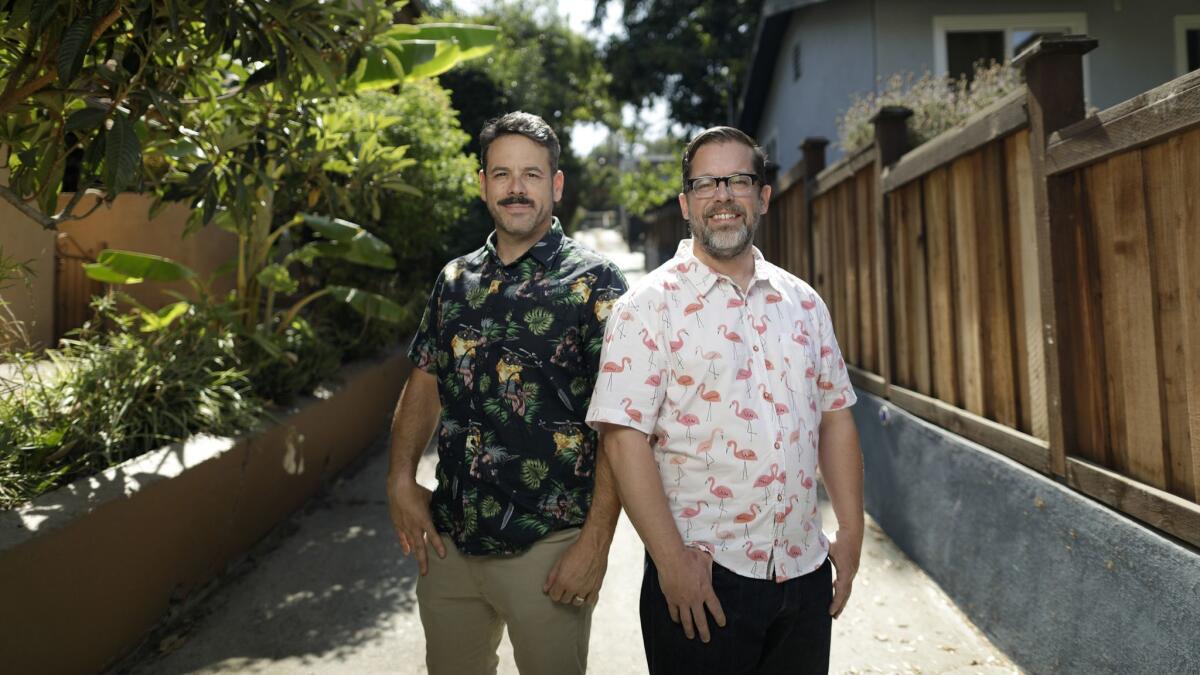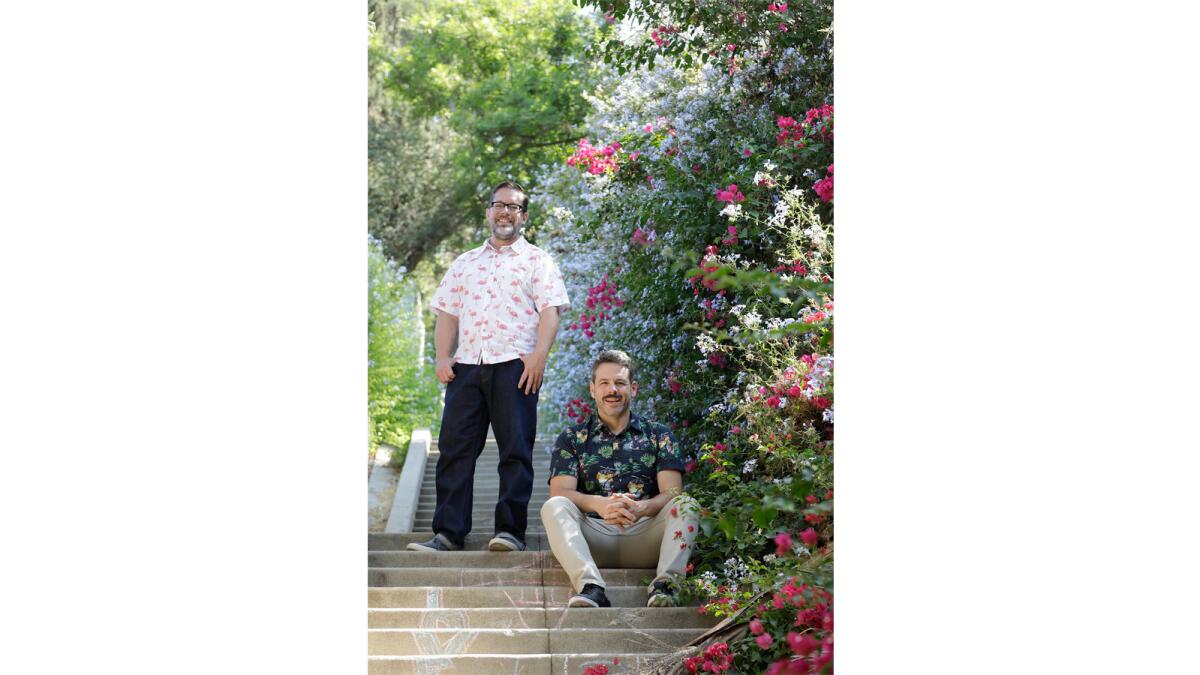In the cutthroat world of reality TV, two Silver Lake neighbors are ‘Making It’

- Share via
When Los Angeles artists Billy Kheel and Robert Mahar talk about their experience on NBC’s popular craft competition “Making It,” what’s most striking is the extent to which genuine camaraderie upstages traditional reality TV elements like backstabbing.
“It was a happy and friendly experience,” says Kheel, who is a felt artist. “The producers told us from the beginning that they didn’t want us to be cutthroat with one another.”
Hosted by comedians Amy Poehler and Nick Offerman, the six-episode series follows eight makers from around the country as they build, paint and stitch their way to a $100,000 grand prize.
So far, Kheel and Mahar have put the L.A. craft community on the map by imbuing their craft challenges — autobiographical terrariums, an oversized felt portrait of NFL linebacker Brian Bosworth, a shadow puppet theater and taco truck — with their unique aesthetic and skill sets.
For Mahar and Kheel, being neighborly is no act.
“It’s amazing to me that they scoured the country for contestants and found two artists who live blocks from each other,” says Mahar, 46, who lives down an alley from Kheel in Silver Lake.
“I remember when the show sent a car for me,” adds Kheel, a 43-year-old father of two. “I saw another car service drive by at the same time and thought, ‘That’s funny. Could there be two of us in the same neighborhood?’”
Kheel thinks the coincidence is a testament to the strong creative community that exists in Los Angeles. “I’m from the East Coast, Robert is from the Midwest, and yet we are both here,” Kheel says. “You get so much inspiration from your fellow makers. During the show, I had no idea what Robert was going to do next.”
We recently caught up with the two artists to ask them about their experience on the show, the importance of the local craft movement and what they listen to while they work.
Describe your aesthetic.
Mahar: “Modern vintage. There is a sense of nostalgia in my work.”
Kheel: “I have a popular culture aesthetic. I am interested in sports iconography and flipping that around. I’m really inspired by Los Angeles: the L.A. River, signs, taco trucks.”
Biggest challenge on the show?
Mahar: “Scale. I felt so accomplished when I finished the play structure because I’m not a woodworker. Just being able to figure out the logistics of how to pull that off was tough — how do I make it smart and sturdy and beautiful? The faster craft is three hours and the master craft is 10 to 13 hours. It was a kick to get better in terms of time management and how I approach a challenge.”
Kheel: “When I was working on a large piece it was “go, go, go!” It’s cool and scary to be thrown into an environment that I can’t control. That’s part of the fun too.”
I hope people will see our spirit, camaraderie and community. Maybe they will incorporate some of that in their own lives.”
— Robert Mahar
British artist Lucy Sparrow told us she listened to true crime podcasts while creating her new, 31,000-piece Sparrow Mart in DTLA. What do you listen to while you work?
Mahar: “Sometimes I will binge-watch a series. It is often incongruous to what I’m working on — watching ‘Handmaid’s Tale’ while doing embroidery. I listen to a lot of community-based craft podcasts like “Dear Handmade Life.”
Kheel: “I like to listen to audiobooks. I recently listened to Twyla Tharp’s ‘The Creative Habit: Learn It and Use It for Life,’ ‘Catching the Big Fish: Meditation, Consciousness, and Creativity’ by David Lynch and ‘Writing Down the Bones: Freeing the Writer Within’ by Natalie Goldberg.”
People often complain about the high cost of handmade goods. Why is it important to support local makers?
Mahar: “I think a lot of it is driven by personal philosophy — some people want to support their community. So many of the vendors I have grown up with are doing amazing things. So maybe instead of getting a friend three small gifts, get them one handmade thing at the Renegade Craft Fair or another hyper-local event.”
Kheel: “I’m not interested in something I’ve seen already. Handmade things are one of a kind. You’re never going to see a felted Happy Foot and Sad Foot sign on Amazon. What is really fascinating to me is how people connect with handmade goods.”
You are both teachers. What do you want to impart to students?
Mahar: We live in an overstyled world of Pinterest and Instagram. I am about process and approaching a new skill set.
Kheel: I’m interested in digging in to students’ interests. I had a kid who was against art but was very interested in jersey swap. Using that as an inspiration, he did drawings, used Photoshop and paper collage. I like to find something that drives an art project.”

What do you hope viewers take away from the show?
Mahar: “I enjoy shows like ‘The Great British Baking Show’ because I love seeing people engage in a creative process that is kind and collegial. I hope people will see our spirit, camaraderie and community. Maybe they will incorporate some of that in their own lives.”
Kheel: “The coolest thing about the show is when kids come up to me and tell me they tried to make a quilt like I did on the show. If people are inspired to put down their phones and try something new, then that’s great.”
Does craft have a future in the cutthroat economic world of e-commerce?
Mahar: “I think it’s hard. I can go to the Renegade Craft Fair and see a popular booth and then the next year I will go to Target and see something similar for $5. I know that crafts drive trends. I think ‘Making It’ can propel people to make things themselves. There is a benefit to making something with your own two hands. It builds community and family bonds. I have managed anxiety and depression this way my entire life. It really helps me focus my energy and time in a healthy way.”
What has the show inspired you to do next?
Mahar: “I’m coordinating the French General Holiday Pop-Up with five other local L.A.-based artists on Dec. 2, 11 a.m. to 4 p.m. The others participating are Cathy Callahan, Jenny Hart (Sublime Stitching), Tyn Atol, Molly Meng, Jody Rice (Satsuma Street).”
Kheel: “I’m curating a group show of fiber artists called Common Thread at Suay Sew Shop in Frogtown in conjunction with the Frogtown Artwalk on Sept. 22 and doing an installation at the Avenue des Artes booth at Complexcon on Nov. 3-4.”
The show has such a positive vibe. Why is that important right now?
Mahar: “The world is a dumpster fire right now. The show is a response to the current climate. It’s important to have an outlet that’s soothing and comforting.”
Kheel: “They wanted us to help one another. Robert joked that they were going to call the show ‘Hell Barn.’ But that never happened. We trusted one another. We all had dinner together recently and the wait staff couldn’t figure out who we were. They knew we weren’t family. We are all so different but we all get along.”
Like neighbors.
“Making It”
Where: NBC
When: 10 p.m. Tuesdays
Info: nbc.com/making-it
ALSO:
Why you need to watch ‘Making It,’ the new Nick Offerman, Amy Poehler DIY competition
Artist Billy Kheel gives offbeat iconography the felt treatment
At this supermarket pop-up, everything is made of felt. Really
More to Read
The complete guide to home viewing
Get Screen Gab for everything about the TV shows and streaming movies everyone’s talking about.
You may occasionally receive promotional content from the Los Angeles Times.







